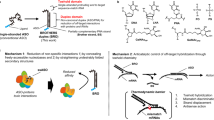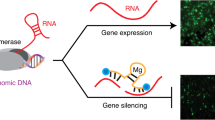Abstract
Factors that govern the specificity of an antisense oligonucleotide (ON) for its target RNA include accessibility of the targeted RNA to ON binding, stability of ON/RNA complexes in cells, and susceptibility of the ON/RNA complex to RNase H cleavage. ON specificity is generally proposed to be dependent on its length. To date, virtually all previous antisense experiments have used 12–25 nt-long ONs. We explored the antisense activity and specificity of short (7 and 8 nt) ONs modified with C-5 propyne pyrimidines and phosphorothioate internucleotide linkages. Gene-selective, mismatch sensitive, and RNase H-dependent inhibition was observed for a heptanucleotide ON. We demonstrated that the flanking sequences of the target RNA are a major determinant of specificity. The use of shorter ONs as antisense agents has the distinct advantage of simplified synthesis. These results may lead to a general, cost-effective solution to the development of antisense ONs as therapeutic agents.
This is a preview of subscription content, access via your institution
Access options
Subscribe to this journal
Receive 12 print issues and online access
$209.00 per year
only $17.42 per issue
Buy this article
- Purchase on Springer Link
- Instant access to full article PDF
Prices may be subject to local taxes which are calculated during checkout
Similar content being viewed by others
References
Stein, C.A. and Cheng, Y.-C. 1993. Antisense oligonucleotides as therapeutic agents—is the bullet really magical? Science 261: 1004–1012.
Stein, C.A. and Krieg, A.M. 1994. Problems in interpretation of data derived from in vitro and in vivo use of antisense oligodeoxynucleotides. Antisense Research and Development 4: 67–69.
Wagner, R.W. 1994. Gene inhibition using antisense oligodeoxynucleotides. Nature 372: 333–335.
Woolf, T.M., Melton, D.A., and Jennings, C.G. 1992 Specificity of antisense oligonucleotides in vivo. Proc. Natl. Acad. Sci. USA 89: 7305–7309.
Herschlag, D. 1991. Implications of ribozyme kinetics for targeting the cleavage of specific RNA molecules in vivo: more isn't always better. Proc. Natl. Acad. Sci. USA 88: 6921–6925.
Wagner, R.W., Matteucci, M.D., Lewis, J.G., Gutierrez, A.J., Moulds, C., and Froehler, B.C. 1993. Antisense gene inhibition by oligonucleotides containing C-5 propyne pyrimidines. Science 260: 1510–1513.
Rittner, K., Burmester, C., and Sczakiel, G. 1993. In vitro selection of fast-hybridizing and effective antisense RNAs directed against the human immunodeficiency virus type 1. Nucleic Acids Res. 21: 1381–1387.
Lima, W.F., Monia, B.P., Ecker, D.J., and Freier, S.M. 1992 Implication of RNA structure on antisense oligonucleotide hybridization kinetics. Biochemistry 31: 12055–12061.
Fenster, S.D., Wagner, R.W., Froehler, B.C., and Chin, D.J. 1994. Inhibition of Human Immunodeficiency Virus type-1 env expression by C-5 propyne oligonucleotides specific for Rev Response element stem loop V. Biochemistry 33: 8391–8398.
Persson, C., Wagner, E.G.H., and Nordström, K. 1990. Control of replication of plasmid R1: structures and sequences of the antisense RNA, CopA, required for its binding to the target RNA, CopT. EMBO J. 9: 3767–3775.
Mishra, R.K. and Toulme, J.J. 1994. In vitro selection of antisense oligonucleotides targeted to a hairpin structure. Comptes Rendus de L Academie des Sciences. Serie III, Sciences de la Vie 317: 977–982.
Laptev, A.V., Lu, Z., Colige, A., and Prockop, D.J. 1994. Specific inhibition of expression of a human collagen gene (COL1A1) with modified antisense oligonucleotides. The most effective target sites are clustered in double-stranded regions of the predicted secondary structure for the mRNA. Biochemistry 33: 11033–11039.
Morgan, R., Edge, M., and Colman, A. 1993 A more efficient and specific strategy in the ablation of mRNA in Xenopus laevis using mixtures of antisense oligos. Nucleic Acids Res. 21: 4615–4620.
Homann, M., Rittner, K., and Sczakiel, G. 1993. Complementary large loops determine the rate of RNA duplex formation in vitro in the case of an effective antisense RNA directed against the human immunodeficiency virus type 1. J. Mol. Biol. 233: 7–15.
Duroux, I., Godard, G., Boidot-Forget, M., Schwab, G., Hélène, C., and Saison-Behmoaras, T. 1995. Rational design of point mutation-selective antisense DNA targeted to codon 12 of Ha-ras mRNA in human cells. Nucleic Acids Res. 23: 3411–3418.
Moulds, C., Lewis, J.G., Froehler, B.C., Grant, D., Huang, T., Milligan, J.F., Matteucci, M.D., and Wagner, R.W. 1995 Site and mechanism of antisense inhibition by C-5 propyne oligonucleotides. Biochemistry 34: 5044–5053.
Lin, K.-Y., Pudlo, J.S., Jones, R.J., Bischofberger, N., Matteucci, M.D., and Froehler, B.C. 1994. Oligodeoxynucleotides containing 5-(1-propynyl)-2′-deoxyuridine formacetal and thioformacetal dimer synthons. Bioorganic & Medicinal Chem. Letters 4: 1061–1064.
Gossen, M. and Bujard, H. 1992. Tight control of gene expression in mammalian cells by tetracycline-responsive promoters. Proc. Natl. Acad. Sci. USA 89: 5547–5551.
Hanvey, J.C., Peffer, N.J., Bisi, J.E., Thomson, S.A., Cadilla, R., Josey, J.A., Hassman, C.F., Bonham, M.A., Au, K.G., Carter, S.G., Bruckenstein, D.A., Boyd, A.L., Noble, S.A., and Babiss, L.E. 1992. Antisense and antigene properties of peptide nucleic acids. Science 258: 1481–1485.
Author information
Authors and Affiliations
Rights and permissions
About this article
Cite this article
Wagner, R., Matteucci, M., Grant, D. et al. Potent and selective inhibition of gene expression by an antisense heptanucleotide. Nat Biotechnol 14, 840–844 (1996). https://doi.org/10.1038/nbt0796-840
Received:
Accepted:
Issue Date:
DOI: https://doi.org/10.1038/nbt0796-840
This article is cited by
-
A Short Antisense Oligonucleotide Ameliorates Symptoms of Severe Mouse Models of Spinal Muscular Atrophy
Molecular Therapy - Nucleic Acids (2014)
-
Antisense-Oligonukleotide zur Therapie der Mukoviszidose
HNO (2009)
-
Bactericidal antisense effects of peptide–PNA conjugates
Nature Biotechnology (2001)
-
Targeted therapy for malignant melanoma
Current Oncology Reports (2001)
-
Cellular penetration and antisense activity by a phenoxazine-substituted heptanucleotide
Nature Biotechnology (1999)



